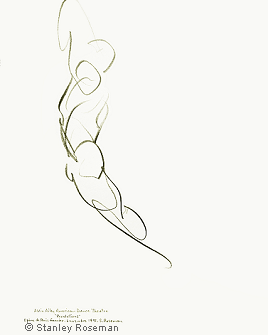
Stanley Roseman
Dessins sur la Danse à l'Opéra de Paris
Dessins sur la Danse à l'Opéra de Paris
Bibliothèque Nationale de France
Bibliothèque-Musée de l'Opéra
13 March - 9 June 1996
Bibliothèque-Musée de l'Opéra
13 March - 9 June 1996
"a hundred magnificent drawings from the artist's oeuvre on the dance"
- Bibliothèque Nationale de France
Exhibition poster: Stanley Roseman - Dessins sur la Danse à l'Opéra de Paris presented by the Bibliothèque Nationale de France.
The poster features Paris Opéra star dancer Charles Jude as Prince Siegfried in Nureyev's choreography of Tchaikovsky's Swan Lake.
The poster features Paris Opéra star dancer Charles Jude as Prince Siegfried in Nureyev's choreography of Tchaikovsky's Swan Lake.

''Drawing has again become movement thanks to you, Stanley, discreet witness of our life on the stage. Thank you for your benevolent regard and bravo for your talent.''*
- Elisabeth Platel
Star Dancer of the Paris Opéra
Star Dancer of the Paris Opéra
Elisabeth Platel, 1996
Paris Opéra Ballet
Allegro Brillante
Pencil on paper, 38 x 28 cm
Bibliothèque Nationale de France, Paris
Paris Opéra Ballet
Allegro Brillante
Pencil on paper, 38 x 28 cm
Bibliothèque Nationale de France, Paris
* Stanley Roseman - Dessins sur la Danse à l'Opéra de Paris
(text in French and English), "Quelques Mots des Danseurs" /
"A Few Words from the Dancers," Elisebeth Platel, Charles Jude,
Bibliothèque Nationale de France, 1996, p. 12.
(text in French and English), "Quelques Mots des Danseurs" /
"A Few Words from the Dancers," Elisebeth Platel, Charles Jude,
Bibliothèque Nationale de France, 1996, p. 12.
On March 1st, 1996, Mozart's Don Giovanni was performed, in concert, in the splendid Palais Garnier, and the following evening, the Paris Opéra presented a new production of the composer's Così fan tutte.
On March 18th, the celebrated Paris Opéra Ballet resumed performances on the stage of the Palais Garnier, once again captivating audiences in that illustrious opera house.
On March 18th, the celebrated Paris Opéra Ballet resumed performances on the stage of the Palais Garnier, once again captivating audiences in that illustrious opera house.
Paris Opéra, Palais Garnier
''Avec ma très sincère admiration''
- Jean Favier
President
- Jean Favier
President
Bibliothèque Nationale de France
The gala reopening of the Paris Opéra, Palais Garnier, was celebrated during the month of March 1996, following more than a year and a half of renovation and refurbishing of the world-famous temple of culture that stands majestically at the top of the grand Avenue de l'Opéra.
Three events marked that gala occasion: the return of regular performances of opera after an absence of seven years, during which time the Opéra Bastille presented operas and concerts; the return of performances by the Paris Opéra Ballet, which in the interim had been presented at the Opéra Bastille; and the opening of the art exhibition Stanley Roseman - Dessins sur la Danse à l'Opéra de Paris.
Three events marked that gala occasion: the return of regular performances of opera after an absence of seven years, during which time the Opéra Bastille presented operas and concerts; the return of performances by the Paris Opéra Ballet, which in the interim had been presented at the Opéra Bastille; and the opening of the art exhibition Stanley Roseman - Dessins sur la Danse à l'Opéra de Paris.
The distinguished President of the Bibliothèque Nationale de France, Jean Favier, Member of the French Institute, opened the exhibition Stanley Roseman - Dessins sur la Danse à l'Opéra de Paris on the evening of March 12th, by invitation, with the opening to the public on the following day. The three-month long exhibition, sponsored by Louis Vuitton, was presented by the Bibliothèque Nationale de France at its library and museum the Bibliothèque-Musée de l'Opéra, housed in the former Emperor's Pavilion in the Palais Garnier.
The first to sign the artist's guest book, Jean Favier writes:
The first to sign the artist's guest book, Jean Favier writes:
For the exhibition publication by the Bibliothèque Nationale de France, Paris Opéra star dancer Elisabeth Platel graciously contributed words of praise for Roseman's work:
"This is the first time that I see the leap, the dancer's flight rendered with such precision in its instantaneity. This drawing of Stanley's marvelously reflects the poetry and the immateriality of movement. I am proud to be the inspiration of this work."*
- Charles Jude
Star Dancer of the Paris Opéra
Star Dancer of the Paris Opéra
"a hundred magnificent drawings from the artist's oeuvre on the dance"
The Bibliothèque Nationale de France states in its exhibition publication Stanley Roseman - Dessins sur la Danse à l'Opéra de Paris / Drawings on the Dance at the Paris Opéra (text French and English): "At the Paris Opéra for the past six years, Stanley Roseman has been 'an honorary member' of the ballet troupe. His drawings on the dance are neither a documentary of a ballet nor of dancers in repose nor readying for a performance." Drawing from the auditorium at dress rehearsals and from the wings of the stage at performances, Roseman uses pencil and paper "to translate and transmit the dancer's movements in a single pictorial image."
The exhibition publication includes "Quelques Mots des Danseurs / A Few Words from the Dancers" and reproductions of a selection of drawings in the exhibition. The magnificent drawing of Elisabeth Platel, (seen above), is rendered with sweeping lines of the pencil depicting the star dancer executing a stunning arabesque in Allegro Brillante, choreographed by Balanchine to the First Movement of Tchaikovsky's Third Piano Concerto.
In the fine art book Stanley Roseman and the Dance - Drawings from the Paris Opéra,
the artist writes a heartfelt acknowledgment:
the artist writes a heartfelt acknowledgment:
"To the dancers,
who have given me inspiration for my work,
I express my profound gratitude."
who have given me inspiration for my work,
I express my profound gratitude."
- Stanley Roseman
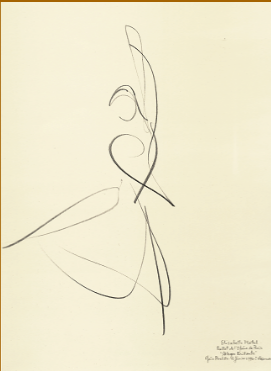
© Stanley Roseman
Les compagnies invitées
During the unprecedented five seasons the Palais Garnier was consecrated to the dance, from 1989-1994, dance companies of international renown were invited to perform at the Paris Opéra. For a number of the invited companies, or les compagnies invitées, it was their first appearance on the stage of the world famous opera house. Those memorable events gave Roseman the occasion to draw dancers of different nationalities in an extensive range of choreographic works and styles of dance.
During the unprecedented five seasons the Palais Garnier was consecrated to the dance, from 1989-1994, dance companies of international renown were invited to perform at the Paris Opéra. For a number of the invited companies, or les compagnies invitées, it was their first appearance on the stage of the world famous opera house. Those memorable events gave Roseman the occasion to draw dancers of different nationalities in an extensive range of choreographic works and styles of dance.
Drawings created at performances of La Bayadère over several seasons were presented in Gallery 3, as seen in the photograph here.
A Golden Age of Dance at the Paris Opéra
Stanley Roseman - Dessins sur la Danse à l'Opéra de Paris presented "a hundred magnificent drawings from the artist's oeuvre on the dance" (Bibliothèque Nationale de France), created during what today is referred to as a Golden Age of Dance at the Paris Opéra.
Stanley Roseman - Dessins sur la Danse à l'Opéra de Paris presented "a hundred magnificent drawings from the artist's oeuvre on the dance" (Bibliothèque Nationale de France), created during what today is referred to as a Golden Age of Dance at the Paris Opéra.
Gallery 3 with a selection of the artist's drawings from Nureyev's last choreography La Bayadère.
8. Laurent Quéval, 1993
Paris Opéra Ballet
Giselle
Pencil on paper, 37.5 x 27.5 cm
Private collection, France
Paris Opéra Ballet
Giselle
Pencil on paper, 37.5 x 27.5 cm
Private collection, France
6. Laurent Hilaire and Isabelle Guérin, 1995
Paris Opéra Ballet
La Bayadère
Pencil on paper, 38 x 28 cm
Private collection, London
Paris Opéra Ballet
La Bayadère
Pencil on paper, 38 x 28 cm
Private collection, London
© Stanley Roseman and Ronald Davis - All Rights Reserved
Visual imagery and website content may not be reproduced in any form whatsoever.
Visual imagery and website content may not be reproduced in any form whatsoever.
The marvelous drawing reproduced above, (fig. 8), depicts Laurent Quéval dancing in a harvest scene from Mats Ek's version of Giselle. A talented dancer esteemed for his character roles, such as Monsieur de G.M. in L'Histoire de Manon, the sorceress (in travesty) in La Sylphide, and the windmill-battling knight in Don Quichotte - roles in which the artist drew the dancer - Laurent Quéval is seen here as a farmer, a tall figure expressed through a minimum of curvilinear pencil lines charged with energy. Roseman vividly renders the figure of Quéval strutting across the page, with his farmer's hat pulled down low on his upturned head.
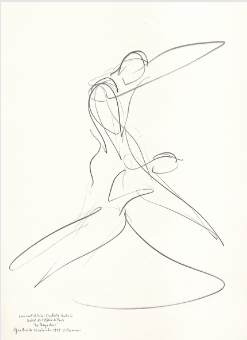
© Stanley Roseman
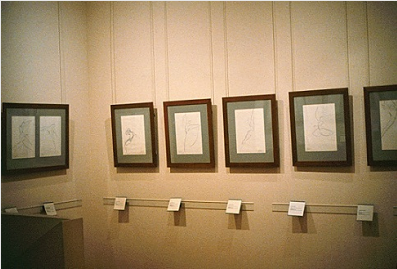
© Photo by Ronald Davis
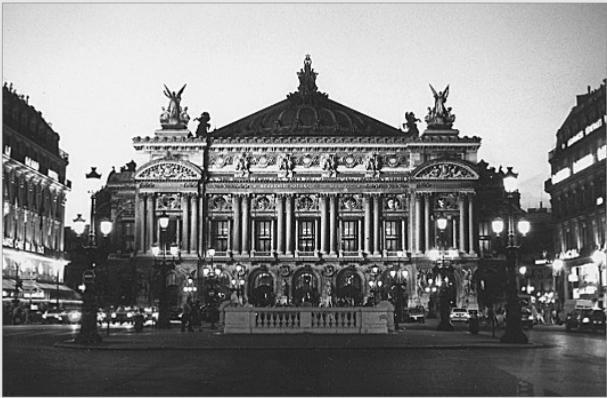
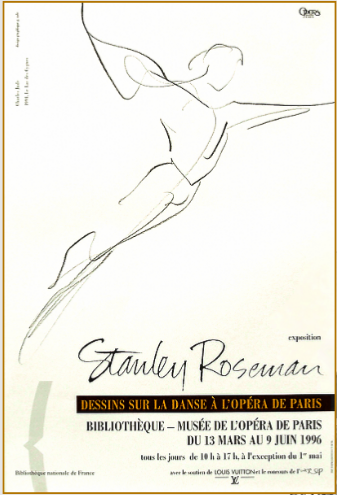
© Photo by Ronald Davis
- Bibliothèque Nationale de France
"Stanley Roseman's drawings show the many facets of his great talents as a draughtsman."
The exhibition poster and the exhibition publication present the superb drawing of star dancer Charles Jude as Prince Siegfried in Nureyev's choreography of Tchaikovsky's Swan Lake. Charles Jude also graciously contributed words of praise for Roseman's work:
4. Charles Jude, 1994
Paris Opéra Ballet
Swan Lake
Pencil on paper, 37.5 x 27.5 cm
Collection of the artist
Paris Opéra Ballet
Swan Lake
Pencil on paper, 37.5 x 27.5 cm
Collection of the artist
The exhibition featured drawings of the dancers of the celebrated Paris Opéra Ballet - the star dancers or étoiles, premier dancers, sujets, and members of the corps de ballet - in an impressive range of Romantic and classical ballets, modern dance, contemporary works, Paris premieres, and world premieres, including the world premiere of Rudolf Nureyev's last choreography, the exotic La Bayadère.
7. Monique Loudières, 1993
Paris Opéra Ballet
Giselle
Pencil on paper, 37.5 x 27.5 cm
Bibliothèque Nationale de France
Paris Opéra Ballet
Giselle
Pencil on paper, 37.5 x 27.5 cm
Bibliothèque Nationale de France
10. Kader Belarbi, 1996
Paris Opéra Ballet
The Four Seasons
Pencil on paper, 38 x 28 cm
Uffizi, Gabinetto Disegni e Stampe,
Florence
Paris Opéra Ballet
The Four Seasons
Pencil on paper, 38 x 28 cm
Uffizi, Gabinetto Disegni e Stampe,
Florence
9. Nicolas Le Riche, 1996
Paris Opéra Ballet
The Four Seasons
Pencil on paper, 38 x 28 cm
Uffizi, Gabinetto Disegni e Stampe,
Florence
Paris Opéra Ballet
The Four Seasons
Pencil on paper, 38 x 28 cm
Uffizi, Gabinetto Disegni e Stampe,
Florence
Roseman's excellent suite from La Bayadère includes drawings of Laurent Hilaire in the role of the noble Indian warrior Solor and Isabelle Guérin as the temple dancer Nikiya, both of whom danced in the world premiere of Nureyev's choreography in October 1992. The beautiful drawing Laurent Hilaire and Isabelle Guérin, presented here, (fig. 6), depicts the two Paris Opéra star dancers in a passionate pas de deux in the first act of La Bayadère.
In this vibrant composition, Roseman has rendered with great fluidity of pencil lines on paper Hilaire as the Indian warrior and Guérin as the lovely temple dancer at an emotionally intense moment dancing their pas de deux as they hold each other and seemingly swirl in pictorial space.
Stanley Roseman - Dessins sur la Danse à l'Opéra de Paris presented a selection of the artist's drawings from the Bolshoi Ballet, Tokyo Ballet, Stuttgart Ballet, Netherlands Dance Theatre, Béjart Ballet Lausanne, Wuppertal Dance Theatre, Marseilles Ballet - Roland Petit, Preljocaj Dance Company, Rosas, American Ballet Theatre, San Francisco Ballet, Alvin Ailey Dance Theatre, Twyla Tharp and Dancers, and the Martha Graham Dance Company.
The beautiful drawing presented here, (fig. 13), depicts Joyce Herring in Graham's El Penitente, choreographed in 1942 to a ballet score composed by the company's musical director Louis Horst.
13. Joyce Herring, 1991
Martha Graham Dance Company
El Penitente
Pencil on paper, 37.5 x 27.5 cm
Private collection, France
Martha Graham Dance Company
El Penitente
Pencil on paper, 37.5 x 27.5 cm
Private collection, France
11. Göran Svalberg, 1990
Béjart Ballet Lausanne
Ring um den Ring
Pencil on paper, 37.5 x 27.5 cm
Private collection, Switzerland
Béjart Ballet Lausanne
Ring um den Ring
Pencil on paper, 37.5 x 27.5 cm
Private collection, Switzerland
The Rotunda of the Bibliothèque Nationale de France - Bibliothèque-Musée de l'Opéra
featuring a spectacular display of Roseman's drawings from the Paris Opéra Ballet's
acclaimed presentations of the original productions of the Ballets Russes:
Petrouchka, L'Après-midi d'un faune, and The Rite of Spring.
See website page "Stanley Roseman and the Ballets Russes."
featuring a spectacular display of Roseman's drawings from the Paris Opéra Ballet's
acclaimed presentations of the original productions of the Ballets Russes:
Petrouchka, L'Après-midi d'un faune, and The Rite of Spring.
See website page "Stanley Roseman and the Ballets Russes."
The Béjart Ballet Lausanne made a guest appearance at the Paris Opéra in March 1990. Roseman knows well Canton Vaud and the Lavaux region along Lake Geneva from living, painting, and drawing there, and as the artist writes in his journal that March: "It is wonderful to have this opportunity to include the Béjart Ballet Lausanne in my work at the Paris Opéra.''
The Béjart Ballet Lausanne presented Ring um den Ring, "un spectacle autour du 'Ring' de Richard Wagner,'' writes the renowned choreographer in the Paris Opéra program notes. From Béjart's fascinating evocation of the Ring cycle, Roseman created a series of impressive drawings, as with the present work that depicts Göran Svalberg as Siegfried, (fig. 11).
Dance companies from the Unites States have also received warm and enthusiastic welcomes from Parisian audiences. The San Francisco Ballet made its first guest appearance at the Paris Opéra in July 1994. Roseman's drawings at performances of diverse ballets and modern dance from the Company's repertory include the exemplary work presented below, (fig. 12).
The Dance first became a subject for Roseman's drawings in New York City in the 1970's, when the artist received cordial invitations from leading dance companies, including the Martha Graham Dance Company. (See the website page "Dance from New York to Paris.'') The company founded by Graham, a pioneer of modern dance, made a return engagement at the Paris Opéra in autumn of 1991.
Roseman recounts: "With excitement I took up my paper and pencil to draw the Martha Graham Dance Company again, albeit from the wings of the stage of the Paris Opéra.''
With a continuous flow of line and a compelling mise en page, Roseman expresses the contained movement and intensity of the dancer, wrapped in a long cape, her face in profile, her body bent forward as she is seen advancing across the picture plane. The artist writes of his drawings on the dance, ''I sought to express not only a dancer's movements that led up to and completed the grand steps and gestures but also intermediate and complementary dance movements that for me spoke personally of the individual dancer.''
The Uffizi Gallery with a world-renowned collection of master drawings acquired a suite of Roseman's drawings on the dance. The acquisition includes two splendid works from The Four Seasons: Nicolas Le Riche, (fig. 9), and Kader Belarbi, (fig. 10), exhibited in Stanley Roseman - Dessins sur la Danse à l'Opéra de Paris.
In preparation for the exhibition, Roseman drew at rehearsals of The Four Seasons in order to include drawings from the Paris Opéra Ballet program that was to open at the Palais Garnier on March 18. The program concluded with the Paris Opéra premiere of The Four Seasons, choreographed by Jerome Robbins to the effervescent ballet music by Giuseppe Verdi from his opera I Vespri Siciliani, with additional music from Jerusalem and Il Trovatore.
With swift, sure lines of a graphite pencil, Roseman expresses the force of Nature conveyed by Nicolas Le Riche in the dance segment "Autumn." Bold pencil strokes define the taut musculature of the male dancer bounding across the picture plane. In the companion work Roseman depicts Kader Belarbi striding forward, arms outstretched and head inclined, in a lyrically expressed dance movement in joyful celebration of Spring.
Complementing the drawings from classical ballet are Roseman's drawings from productions of modern dance. The exhibited drawings in Gallery 3 also featured a selection from the contemporary retelling of Giselle by the Swedish choreographer Mats Ek, whose version retains the celebrated score by Adolphe Adam. Monique Loudières portrayed with pathos and deeply felt emotion the tragic young heroine. The Bibliothèque Nationale de France conserves the excellent drawing Monique Loudières, (fig. 7, below). The Paris Opéra star dancer stands with legs astride and bent at the knees, arms stretched over her head, and her torso arched to the left in a modern dance movement poignantly expressive of Giselle's anguish in being deceived by the man she loves.
The dancer is seen here in profile in a kneeling position whereby the dancer's muscular thigh, buttock, and torso, his head leaning back, and an arm thrust high in the air form a strong diagonal composition. With a striking use of pictorial space and "a few masterful strokes of a pencil'' (Associated Press, Paris), Roseman creates a forceful image of the male dancer.
In the impressive drawing Male Dancer, a single, curvilinear stroke of the pencil delineates the dancer's neck, head, and cowboy hat. Vigorous lines describe the cowboy's raised shoulders in counterpoint to his lifted, left leg, bent at the knee, and his right leg, a pillar of support. With economy of line, Roseman skillfully transmits the exuberance of the male dancer in Rodeo.
12. Male Dancer, 1994
San Francisco Ballet, Rodeo
Pencil on paper, 37.5 x 27.5 cm
Private collection, Switzerland
San Francisco Ballet, Rodeo
Pencil on paper, 37.5 x 27.5 cm
Private collection, Switzerland
"As an American in Paris,'' Roseman recounts, "I was very happy to include in my drawings on the dance at the Paris Opéra the American ballet Rodeo by the distinguished American choreographer Agnes de Mille to a rousing score by the eminent American composer Aaron Copland. This celebrated ballet which premiered in 1940 has a Western theme with dancers in cowboy hats and boots and dance sequences that include tap dancing and a traditional American square dance.''
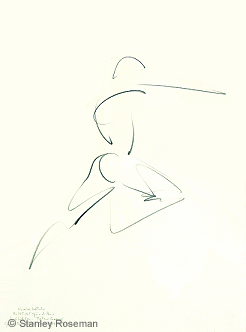
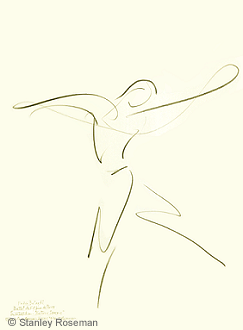
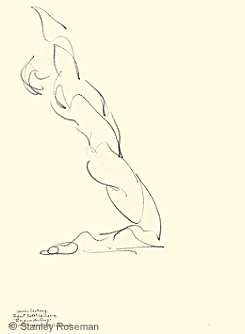
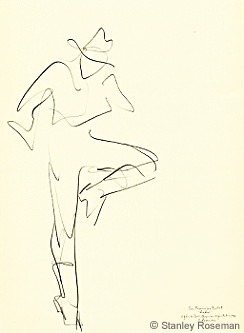
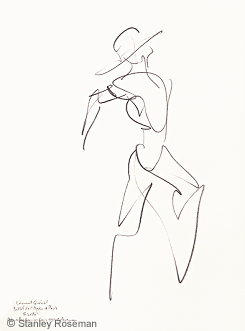
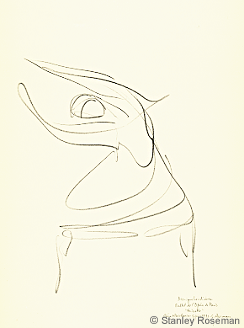

The artist at the exhibition
Stanley Roseman - Dessins sur la Danse à l'Opéra de Paris
presented by the Bibliothèque Nationale de France, 1996.
Stanley Roseman - Dessins sur la Danse à l'Opéra de Paris
presented by the Bibliothèque Nationale de France, 1996.
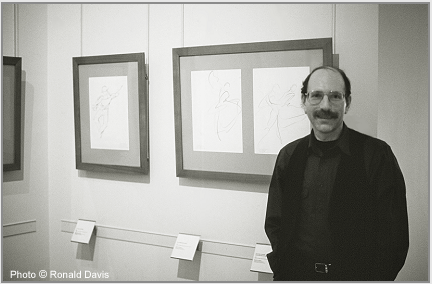
The Alvin Ailey American Dance Theatre, an ensemble of excellent, multi-racial dancers, made a first guest appearance at the Paris Opéra in 1992. Alvin Ailey founded his company in New York City in 1958, and the celebrated choreographer brought his African-American heritage to a repertory of outstanding works of modern dance. Revelations, which premiered in 1960, became Alvin Ailey's acclaimed signature work.
Modern Dance
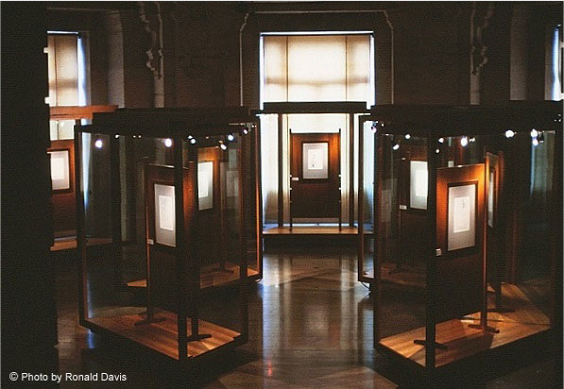
The Bibliothèque Nationale de France exhibition of Roseman's drawings on the dance included a major selection on modern dance from the Paris Opéra Ballet and the invited companies, as seen above and here.
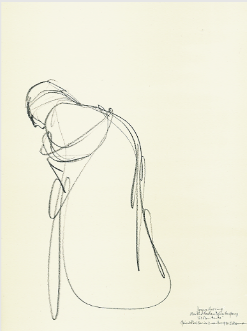
Choreographed to gospel songs, spirituals, and blues, Revelations tells of the enduring faith of African-Americans from slavery to freedom. Revelations comprises three sections: the plaintive "Pilgrim of Sorrow;'' the baptismal imagery of "Take Me to the Water,'' and the concluding "Move, Members, Move,'' with the fervent call: "Oh, sinner man, where you gonna run to'' and the jubilant finale "Rocka My Soul in the Bosom of Abraham.''
Roseman's impressive drawings from Revelations include a dynamic image of a male dancer in a thrilling leap, (fig. 14). Placing the figure high on the page, the artist renders with swift, strong, fluent strokes of a graphite pencil the muscular male physique which seems to defy the pull of gravity. The upward reach of the dancer emphasizes the spirit of freedom expressed in this superb drawing.
14. Male Dancer, 1992
Alvin Ailey American Dance Theatre
Revelations
Pencil on paper, 37.5 x 27.5 cm
Private collection, France
Alvin Ailey American Dance Theatre
Revelations
Pencil on paper, 37.5 x 27.5 cm
Private collection, France
